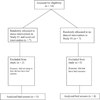Nighttime restfulness during daytime dance therapy: an exploratory study using bed sensors
- PMID: 24005243
- PMCID: PMC4283802
- DOI: 10.1177/0193945913503716
Nighttime restfulness during daytime dance therapy: an exploratory study using bed sensors
Abstract
Dance-based therapy has the potential to slow the progression of functional limitations in older adults. The purpose of this study was to explore the feasibility of measuring the impact of dance-based therapy on the nighttime restfulness patterns of older adults in an aging-in-place facility using passive bed sensors. A secondary data analysis of the continuous 2-month nighttime bed sensor data was reviewed for measurable change during a dance study. A measurable variation in nighttime restfulness level was detected between the dancers and nondancers, and no high or very high restlessness was detected during this period for the dance-based therapy group. Although these exploratory variations are modest, the findings suggest that bed sensors can be used to measure nighttime restfulness following a therapeutic dance intervention. More research is needed in this emerging area.
Keywords: exercise; gerontology; health behavior; population focus; sleep; symptom focus.
Conflict of interest statement
The author(s) declared no potential conflicts of interest with respect to the research, authorship, and/or publication of this article.
Figures
Similar articles
-
Dancing for Healthy Aging: Functional and Metabolic Perspectives.Altern Ther Health Med. 2019 Jan;25(1):44-63. Altern Ther Health Med. 2019. PMID: 29428927 Review.
-
Impact of creative dance on subjective well-being amongst older adults: an arts-informed photo-elicitation study.Arts Health. 2024 Feb;16(1):15-31. doi: 10.1080/17533015.2022.2156562. Epub 2022 Dec 15. Arts Health. 2024. PMID: 36519236
-
Exploring the effects of dance-based therapy on balance and mobility in older adults.West J Nurs Res. 2013 Jan;35(1):39-56. doi: 10.1177/0193945911423266. Epub 2011 Nov 1. West J Nurs Res. 2013. PMID: 22045782 Clinical Trial.
-
Social Dancing and Incidence of Falls in Older Adults: A Cluster Randomised Controlled Trial.PLoS Med. 2016 Aug 30;13(8):e1002112. doi: 10.1371/journal.pmed.1002112. eCollection 2016 Aug. PLoS Med. 2016. PMID: 27575534 Free PMC article. Clinical Trial.
-
Association of Dance-Based Mind-Motor Activities With Falls and Physical Function Among Healthy Older Adults: A Systematic Review and Meta-analysis.JAMA Netw Open. 2020 Sep 1;3(9):e2017688. doi: 10.1001/jamanetworkopen.2020.17688. JAMA Netw Open. 2020. PMID: 32975570 Free PMC article.
Cited by
-
A semi-supervised approach to unobtrusively predict abnormality in breathing patterns using hydraulic bed sensor data in older adults aging in place.J Biomed Inform. 2023 Nov;147:104530. doi: 10.1016/j.jbi.2023.104530. Epub 2023 Oct 20. J Biomed Inform. 2023. PMID: 37866640 Free PMC article.
-
Physical Activity in Older Persons.Mo Med. 2017 Mar-Apr;114(2):105-109. Mo Med. 2017. PMID: 30228555 Free PMC article.
References
-
- Administration on Aging. Disease prevention and health promotion services (OAA Title IIID): Intermediate criteria. 2012 Retrieved from http://www.aoa.gov/AoARoot/AoA_Programs/HPW/Title_IIID/index.aspx.
-
- Keough J, Kilding A, Pideon P, Axhey L, Gillis D. Physical benefits of dance for healthy older adults: A review. Journal of Aging and Physical Activity. 2009;17:1–23. - PubMed
-
- Krampe J. Exploring the effects of dance-based therapy on balance and mobility in older adults. Western Journal of Nursing Research. 2011;35:39–56. - PubMed
-
- Krampe J, Rantz MJ, Dowell L, Schamp R, Skubic M, Abbott C. Dance-based therapy in a program of all-inclusive care for the elderly: An integrative approach to decrease fall risk. Nursing Administration Quarterly. 2010;34:156–161. - PubMed
MeSH terms
Grants and funding
LinkOut - more resources
Full Text Sources
Other Literature Sources
Miscellaneous




